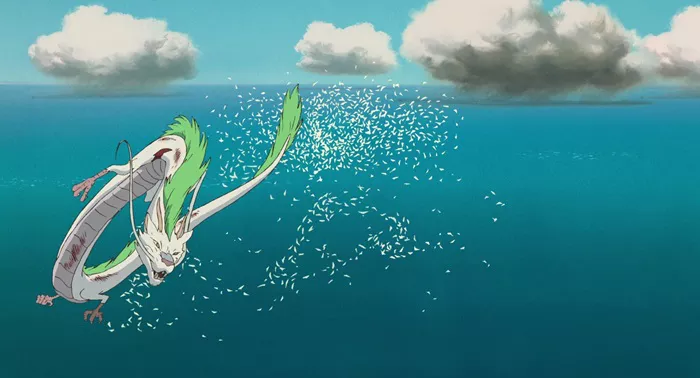In Hayao Miyazaki’s acclaimed animated film Spirited Away, the portrayal of paper birds carries profound symbolic significance. The film, which won the Academy Award for Best Animated Feature in 2003, is renowned for its rich tapestry of themes and imagery. Among its many symbolic elements, the paper birds stand out as a particularly intriguing motif. This article delves into the meaning of these delicate creatures, exploring their symbolism, cultural significance, and role within the narrative of Spirited Away.
Miyazaki’s World of Symbolism
Hayao Miyazaki is a master of infusing his films with layers of meaning, drawing from various cultural, philosophical, and personal sources. Spirited Away is no exception. Set in a magical bathhouse run by spirits, the film follows the journey of Chihiro, a young girl who becomes trapped in this otherworldly realm and must find a way to rescue her parents, who have been transformed into pigs. Throughout her adventure, Chihiro encounters numerous symbolic elements that enrich the film’s narrative and themes.
The Symbolism of Paper Birds
Cultural Significance
Paper birds in Spirited Away are deeply rooted in Japanese cultural and spiritual traditions. In Japanese culture, paper is associated with purity and transformation. Origami, the art of paper folding, symbolizes the process of change and growth. Paper birds, specifically cranes, hold a significant place in Japanese folklore. The crane is a symbol of longevity, good fortune, and peace.
The act of folding paper into birds, particularly cranes, is believed to bring about wishes and prayers. This cultural background provides a rich context for understanding the role of paper birds in the film.
Connection to Chihiro’s Journey
In Spirited Away, paper birds are not merely decorative elements; they play a crucial role in Chihiro’s journey. The most notable appearance of paper birds is during Chihiro’s encounter with Zeniba, Yubaba’s twin sister. Zeniba lives in a quaint cottage surrounded by a serene, natural landscape, in stark contrast to the bustling bathhouse. Here, the paper birds are seen fluttering around, adding to the tranquil and mystical atmosphere.
Symbol of Transformation
The paper birds serve as a symbol of transformation, mirroring Chihiro’s own journey of self-discovery and growth. At the beginning of the film, Chihiro is portrayed as a timid and uncertain girl. Her journey through the spirit world forces her to confront her fears, make difficult choices, and ultimately transform into a more resilient and self-assured individual. The paper birds, with their delicate and ephemeral nature, reflect this process of transformation.
Connection to Themes of Memory and Identity
Another layer of meaning associated with the paper birds is their connection to themes of memory and identity. Throughout the film, Chihiro grapples with her identity and the memories of her past life. The paper birds, as transient and delicate entities, symbolize the fragility of memory and the importance of holding on to one’s true self amidst change.
In one of the pivotal scenes, Chihiro encounters a paper bird that carries a message from Zeniba. This interaction underscores the idea that even in the face of change, there are enduring connections and messages that transcend the physical realm.
See Also: The Symbolism and Meaning of Bath Tokens in Spirited Away
Detailed Analysis of Key Scenes
Encounter with Zeniba
The scene where Chihiro meets Zeniba is crucial to understanding the role of paper birds in the film. Zeniba’s home is filled with paper birds, creating a serene and magical atmosphere. The paper birds flutter around, emphasizing the peaceful and harmonious environment that Zeniba has created.
This setting contrasts sharply with the chaotic and oppressive environment of the bathhouse. The presence of paper birds highlights the themes of balance and harmony, suggesting that true peace can be found through transformation and understanding.
The Paper Bird as a Messenger
The paper bird that carries a message from Zeniba to Chihiro is a key element in the narrative. This paper bird symbolizes the connection between the two characters and the exchange of wisdom and guidance. The delicate nature of the paper bird emphasizes the fragility of communication and the importance of receiving and understanding messages from others.
The Transformation Scene
In a pivotal scene, Chihiro’s transformation is mirrored by the transformation of the paper birds. As Chihiro gains confidence and understanding, the paper birds seem to flutter more energetically, reflecting her growth and change. This visual metaphor reinforces the idea that transformation is a central theme in the film.
The Paper Birds’ Role in the Film’s Resolution
Symbolizing Resolution and Reconciliation
As the film approaches its climax, the paper birds play a symbolic role in the resolution of Chihiro’s journey. The final scenes, where Chihiro returns to the human world, are marked by a sense of closure and reconciliation. The paper birds, with their ephemeral and delicate presence, symbolize the resolution of Chihiro’s journey and the restoration of balance in her life.
Connecting with Chihiro’s Growth
The final appearance of the paper birds serves as a reminder of Chihiro’s growth and the lessons she has learned. The paper birds’ presence in the final scenes underscores the transformation that has taken place, both in Chihiro’s character and in the world around her.
Conclusion
The paper birds in Spirited Away are more than mere decorative elements; they are rich with symbolic meaning. Rooted in Japanese cultural traditions, they symbolize transformation, memory, and identity. Through their delicate and ephemeral nature, the paper birds reflect Chihiro’s journey of growth and self-discovery. As Chihiro navigates the challenges of the spirit world, the paper birds serve as a poignant reminder of the fragility and beauty of transformation. Their role in the film’s narrative underscores the importance of understanding and embracing change, making them a powerful and meaningful symbol in Hayao Miyazaki’s enchanting story.


